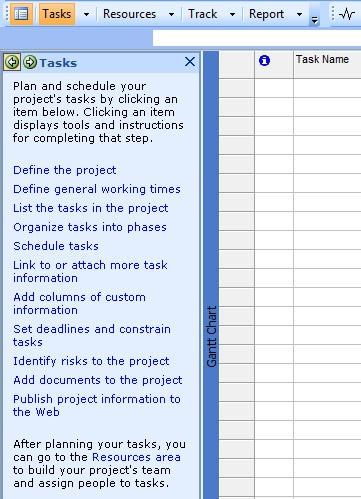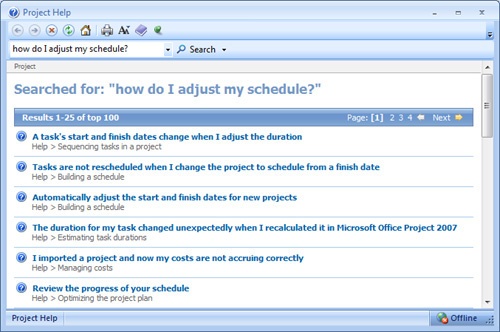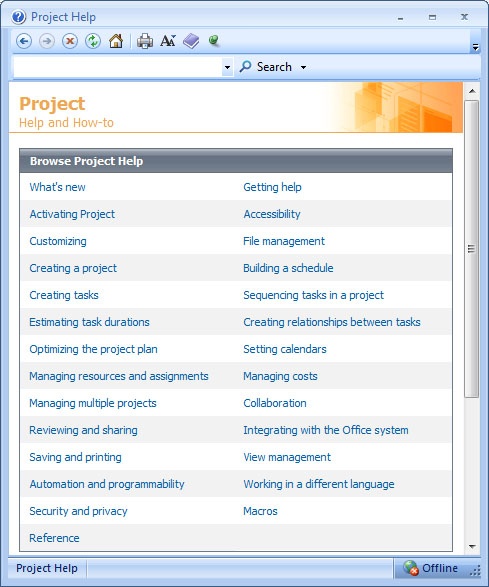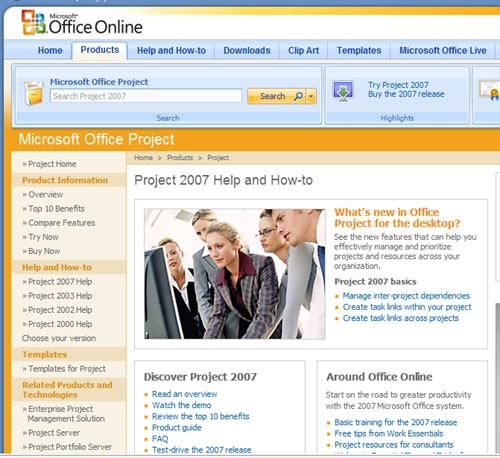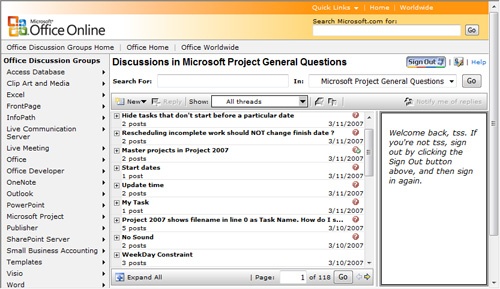As you work in your project plan, you can quickly get assistance and other information when you need it—from the Project Guide, from Help, from Office Online, and other sources.
When you first start Microsoft Project, the Project Guide appears in the task pane on the left (see Figure 1-16).
The Project Guide helps you work through the major aspects of defining, tracking, and reporting on your project. It provides topics, instructions, controls, and wizards that assist your current work in your plan. The Project Guide takes note of your current view and current activities and presents a list of relevant topics and tools within that context.
For example, while you’re working in the Gantt Chart, the Project Guide displays the Tasks guide, which contains topics directly related to entering and scheduling tasks. If you then switch to a resource view, the Project Guide displays the Resources guide, now presenting topics and controls related to entering and assigning resources. There are also groups of topics for tracking and reporting.
You can control the content in the Project Guide by using the Project Guide toolbar just above the Project Guide pane. Use the buttons on this toolbar to display any Project Guide list or topic you want to see. You can view the Tasks, Resources, Track, or Report lists; display any topic on those lists; and toggle the display of the Project Guide pane on and off.
Note
If you’re concerned about the real estate that the Project Guide is taking up on your screen, you can temporarily turn the Project Guide off and then turn it on again whenever you like. Click the Close button in the Project Guide pane or click the Show/Hide Project Guide button on the Project Guide toolbar. When you want the pane back, click the button again.
When you click a topic in the Project Guide, you might find concise text about how to carry out the activity. Or you might click a control in the Project Guide, and the activity is done for you on the spot.
The Project Guide also includes wizards to help automate or walk you through certain processes. With a wizard, the Project Guide asks you specific questions about the activity you want to carry out. As you answer the questions, the wizard pulls together your answers and executes the task automatically, without your having to search for and work with the appropriate dialog boxes in the appropriate views. The following is a list of Project Guide wizards:
Define The Project Wizard. Helps you create a new project plan, either from scratch or from an existing template (see Figure 1-17). This wizard integrates all the tasks you need to create a new project: entering basic project information, setting team collaboration options, adding supporting documentation, and saving the project file.
Project Working Times Wizard. Simplifies the methods of specifying and changing working days and hours, nonworking days and hours, and time units. You can use the Project Working Times Wizard for the project as a whole, in alternative calendars such as a weekend shift, and for specific resources.
Setup Tracking Wizard. Determines how you collect and enter progress information about tasks. Based on the information you provide, the Setup Tracking Wizard designs a tracking view for your specific purposes.
Print Current View Wizard. Sets up the current view to be printed the way you want. You can specify the length of the view to be printed as a report, preview the view as it will be printed, change the dimensions of the report, and modify the content to be included. You can also set the header, footer, and legend for the view.
Note
If you don’t want to use the Project Guide at all, you can turn it off so it doesn’t appear when you start Microsoft Project. Click Tools, Options and then click the Interface tab. Clear the Display Project Guide check box. The Project Guide and its toolbar are hidden. The Project Guide no longer opens when you start up Microsoft Project, and the Project Guide toolbar is not even listed on the Toolbars menu.
In Project 2007, the new Task Drivers pane has been added to the Track guide. On the Project Guide toolbar, click the Track menu and then click See What Is Driving The Start Date Of A Task. You can also click Task Drivers on the Standard toolbar. The Task Drivers pane appears, showing the list of factors responsible for the scheduling of the current task.
You can find Help topics to assist you with your project plan. A large set of Help topics is installed and available with Microsoft Office on your local computer. Another set of Help topics and other forms of assistance are available on the Web through Office Online. You can:
Search for topics using key words or phrases.
Browse the Help table of contents.
Browse for additional resources on Office Online.
Join and ask questions from a Microsoft Project discussion group.
Rather than going through a particular structure of topics, it’s often faster to just ask a direct question and get a direct answer. If you prefer to get your help that way, search using a question or phrase as follows:
In the upper-right corner of the Microsoft Project window, click in the Type A Question For Help box.
Type your question in the box and press Enter.
The Project Help pane appears with a list of Help topics related to your question (see Figure 1-18).
Click a topic that matches what you’re looking for and read an article or procedure about your question.
To read a different Help topic that was listed, click the Back button to return to the list of topics and click the other topic.
If you’re connected to the Internet, you can expand your keyword search to include help available on Office Online. This way, you can access new content much more quickly than wiating for a service pack to update your offline help files. In the lower-right corner of the Project Help pane, click the Offline button.
In the menu that appears, click Show Content From Office Online. When you are connected to Office Online, Help search results appear both from your local Help topics as well as from any related topics on the Office Online Web site.
If you want to see Help topics in a logical sequence, follow these steps:
Click Project Help on the Standard toolbar.
The Project Help window appears showing a table of contents of major topics (see Figure 1-19).
Click the name of the category of topics.
In the topic list, click a link to view the Help topic.
Note
In addition to clicking the Project Help button on the Standard toolbar, you can open the Project Help pane by simply pressing F1.
If you’re connected to the Internet and Office Online, you see even more categories and topics listed in the Project Help pane.
There is a Help topic for each and every field in Microsoft Project. One way to find such topics is by browsing the Project Help contents, as follows:
On the Standard toolbar, click Project Help.
At the bottom of the Browse Project Help categories, click Reference.
Click Fields Reference.
Click the topic for the field you want to learn more about.
Each field reference topic includes best uses, examples, calculations if applicable, and particular issues to be aware of when working with this field.
You can also open a field reference Help topic if the field is showing in a table. Rest your mouse pointer over the column heading for a field. A ToolTip appears, indicating the name of the field as a link (see Figure 1-20). Click the field name link. The Help topic for that field appears.
Many of the more complex dialog boxes in Microsoft Project have associated Help topics. One way to find such topics is from the Help Table Of Contents, as follows:
On the Standard toolbar, click Project Help.
At the bottom of the Browse Project Help categories, click Reference.
Click Dialog Box Reference.
The dialog boxes’ topics are listed in alphabetical order. Each dialog box reference topic includes steps on how to open the dialog box and contains descriptions of each field and control in the dialog box.
Click the name of the dialog box you want to learn more about.
You can also open a dialog box reference Help topic if you already opened the dialog box. Many dialog boxes include a Help button. Click that Help button, and the topic for that dialog box appears. If a dialog box does not have a Help button, there is no associated Help topic—ostensibly because the dialog box was considered self-explanatory enough not to require a separate Help topic.
You have already seen how you can click the Offline button in the lower-right corner of the Project Help pane to search on a keyword or browse the contents of Project Help topics on Office Online on the Web. As long as you’re connected to the Internet, you can also simply open Office Online in a full Web browser window. To do this, follow these steps:
In Microsoft Office Project 2007, click Help, Microsoft Office Online.
A Web browser appears showing the Microsoft Office Online Web site. Review the various tabs available, including Products, Help And How-To, and Downloads.
Click the Products tab and then click Project in the side pane to see a set of Web resources having to do with Microsoft Project, including news, downloads, and articles.
In the side pane of this page, click Project 2007 Help to see a comprehensive list of articles and other Microsoft Project resources (see Figure 1-21). Some articles provide step-by-step instructions. Others have conceptual information about Microsoft Project features. Still others provide advice about project management solutions using Microsoft Project. There is access to information in the Microsoft Project Knowledge Base and Microsoft TechNet.
It’s often easiest to learn from your more experienced buddies. A built-in group of knowledgeable friends willing to help can be found on Office Online. There you will find a Microsoft Project discussion group that can help you find answers to your questions and also learn from questions posed by other users. To find and join a Microsoft Project discussion group:
On Office Online, click the Products tab.
In the side pane, click Project.
Toward the bottom of the page, under Additional Resources, click Discussion Groups.
The Discussions In Microsoft Project page appears (see Figure 1-22). You can search for a particular topic or browse through a list of topics in the General Questions, the Microsoft Project Server, or the Microsoft Project Developer discussion group.
If you want to ask a question, first see whether your question has been asked (and answered) previously. Enter a key word or phrase in the Search For box, click the discussion group in the In box, and then click Go.
It’s a great idea to do this before posting a new question, especially if you’re a newer user.
If you don’t find anything in the archives that answers your question, click the Sign In button to sign in with your Windows Live ID. Then click New, Question. You can type your question and post it to the discussion group.
You’ll find that you’ll get great answers to your questions, often quite quickly. If you stick around long enough, you’ll soon find that you’re knowledgeable enough to answer others’ questions. To reply to an existing question, click the Reply button. Enter your answer and post it to the discussion group.
When you make certain types of adjustments to your project plan, Microsoft Project can present Smart Tag indicators with option buttons (see Figure 1-23). These Smart Tags specify the action you’ve just taken, along with any possible implications that action might have. You get information, especially in certain ambiguous situations, to make sure that the result is really your intention. You also see options to switch to a different action if you intended a different outcome.
Figure 1-23. A Smart Tag is first marked with a triangle marker in the affected cell. When you move your mouse pointer over the marker, the Smart Tag indicator appears. Click the indicator, and the options appear.
There are four times at which indicators and option buttons might appear—when you are:
Adding, changing, or removing resource assignments.
Changing start or finish dates.
Editing work, duration, or units.
Deleting a task or resource in the Name column.
The indicator appears in the cell as long as the edit is available for an Undo operation. After you make a new edit, the indicator disappears.
You cannot change or create your own feedback messages in Microsoft Project.
You can turn off the display of indicators and option buttons. Click Tools, Options and then click the Interface tab. Under Show Indicators And Options Buttons For, clear the check boxes for the category of changes for which you don’t need indicators.

